Review article on 3D building technologies
3D printing technologies are conquering the world and this is a real scientific and technological revolution taking place before our eyes. Looking at the speed at which ideas, which have recently been fantastically transformed into everyday life, such as making man-made prostheses for human hands, can be translated into everyday life, not only futurologists, but also experts, are confidently talking about future significant changes in the life of human society. And if in some sectors of the national economy the practical applicability of 3D printing is no longer in doubt, it is medicine, engineering, radio engineering and electronics, then in such a weighty industry as construction, volumetric printing robots look like expensive toys. Are 3d printers capable of real jobs in construction?
As you know, the main difference between a 3D printer and any other industrial robot is in the way of creating products. In particular, a 3D construction printer has a nozzle or an extruder and squeezes a fast-hardening working mixture out of it. The surface on which the volumetric product is created is called the working area and has the dimensions given by the nozzle stroke. And the formwork is not required. That is, the construction machine of volumetric printing is declared as a self-sufficient mechanism capable, when connecting electricity, to create a finished building literally from scratch.
There are three ways to create a three-dimensional structure:
1. Layer-by-layer extrusion of a viscous working mixture.
In this case, a creamy mixture of concrete with additives is squeezed out of the working “nozzle”, like a toothpaste from a tube.
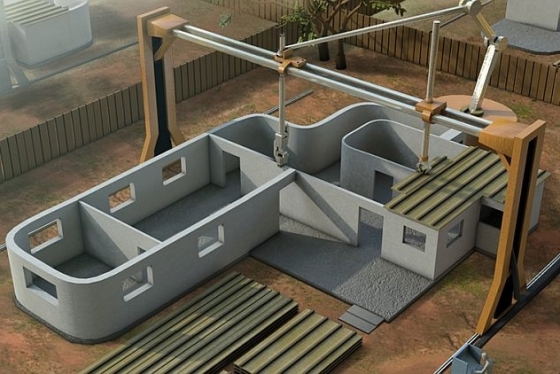
')
He was the first to substantiate the concept of using a robot in construction, in the form of a crane-manipulator, placing a viscous concrete mix according to a given program, industrial designer Sergey Dudin together with specialists from the Moscow Institute of Chemical Engineering named after DI Mendeleev in 1995. The first public presentation of a similar technology in construction, organized by Professor Baruch Koshnewitz of the University of Southern California (University of Southern California) in August 2012. His group put forward the concept of a giant, assembled at the construction site of a printer like a bridge crane.
A group of scientists led by Dr. Sungwu Lima of Loughborough University, a British university, have printed the world's first hollow panel with double rounded contours.

The 3D printers of the Chinese company Shanghai WinSun Decoration Design Engineering Co, which first printed a series of real houses in early 2014, are built on the same principle.
2. Sintering method / selective sintering.
With this technology, in the working area of the 3D machine, the working mixture is melted, and melting is achieved, as applied to construction, by concentrated laser or a sunbeam, and the working mixture is ordinary sand. It is known, at the time of this writing, about the only existing sample of such a device, the inventor Marcus Kaiser, a student of the Royal College of Art (Royal College of Art).
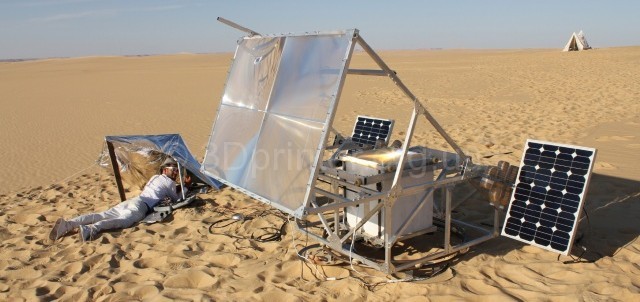
3. Method of spraying / component glueing.
Known, in particular, a working sample of the Catalan Institute of Advanced Architecture (IAAC) group (Peter Novikov group) called Stone Spray Robot, as well as the D-Shape system developed by Enrico Dini (Monolite UK, (private company)) for the construction of buildings. At the same time, a stream of sand comes out of the working nozzle, which is immediately mixed with an adhesive / catalyst, forming a volume at a programmatically defined point.
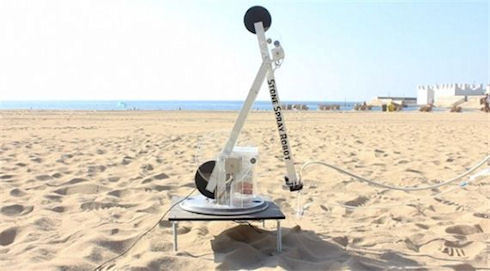

Sintering and spraying methods, elegantly conceived because they use solar energy, are environmentally harmless (at least as long as there is a lot of sand on the planet), you can watch the movement of sand streams for hours and products come out in very unusual forms. Well, already now it is quite possible to build in such a way small architectural forms, a flower girl, for example, or a doghouse. In the meantime, it is difficult to even imagine what the resulting operational effect will be when creating a real, albeit small, house from molten sand and turned into a vitreous mass.
Of these methods of forming a volume, the attention of builders is attracted primarily by the method of layer-by-layer extrusion largely because sufficiently large bearing surfaces and even real houses have already been created.
And if European architects demonstrate, first of all, an aesthetic and ecological orientation, then the Chinese in their developments are extremely pragmatic.
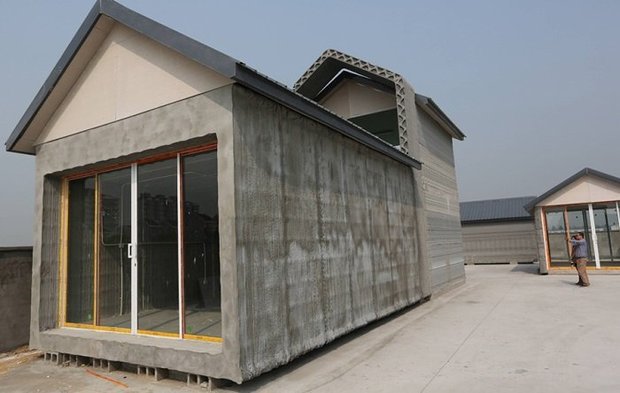
Many 3D romantics frankly disappointed a series of simple and rude-looking houses of a Chinese company. At the same time, it is overlooked that these rectangular plain-wall structures are part of a clearly defined technological chain.
It is planned to massively build factories for the processing of construction waste and garbage, the resulting material will be used in the preparation of the working mixture for a 3D printer. Given China's great achievements in the field of bioenergy, namely the prevalence of wind, solar and bioelectric power plants, it can be assumed that giant construction waste shredders will be installed at landfills of construction debris, powered by electricity from the nearest bioelectric power station.
Constructed from a patented material (which is a mixture of construction waste, concrete and additives), the houses are segmented in the class of inexpensive prefabricated housing. This explains their inconspicuous appearance.
If we talk about the technology of 3D construction. then I would not put the 3D device in the first place. A construction printer is a link in a new technology, and perhaps not the most technically difficult.
After all, the construction of the construction robot is sufficiently developed. and for now houses are only Chinese series. Already there are in many instances two types of structures - in the form of a gantry crane and in the form of a boom-arm.
Much more questions are caused by the composition of the working mixture and conceptual architectural forms. In general, when drafting a working questionnaire on the topic, more than 30 items were formed on the move, the answer to some of them, according to the hilarious remark of engineer Sergei Zotov, requires writing a decent monograph. Zotov's group has already developed the composition of the working mixture and a 3D printer in the version of a “bridge crane”.
Also, an interesting concept, based on the idea of supplying the working mixture under high pressure to a 3D printer that has a rather elegant bridge structure, was proposed by industrial designer Sebastian Bernard.
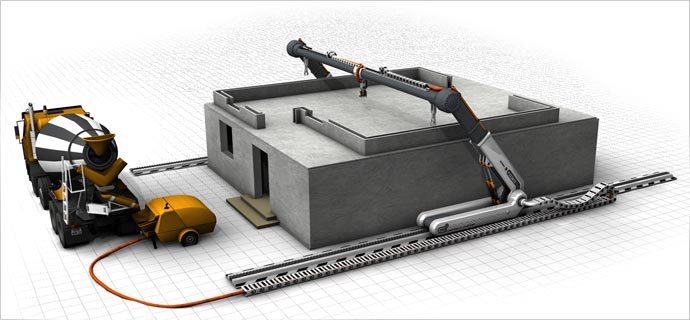
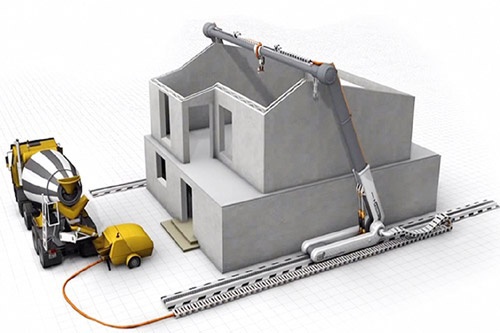
The supply of thick concrete under high pressure translates the technology of bulk printing into a fairly realistic frame. Further, materials are being developed specifically for the application of this technology. In Russia, studies are known in Penza, at the Department of TBKiV of the Penza GUAS new types of concrete are being developed. New high-strength reactionary powder concretes (RPB) are quite suitable for construction robots.
For building a technological process, in addition to the working mixture, the important point is the architecture of the building itself and the group of buildings as a single building object. The most promising direction for Russia, apparently, is the construction of a village of two-storey town houses of arched forms. Approximately such as the domed house of architect Grebnev.
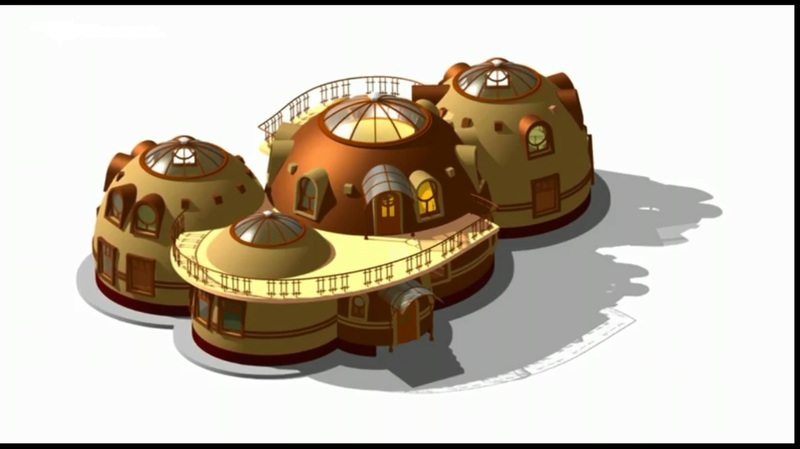
The format of an arched house with two floors will allow the use of relatively small and inexpensive 3D printers, solve the problem of overlapping and allow you to build, really, quickly, massively and inexpensively. And beautiful. On the scale of the settlement, bridge printers can also be used, since the rail track (not necessarily from metal rails) will move as construction progresses.
Many questions are directly related to construction technology. Firstly, how the seams going through every three to five centimeters will affect the strength of the structure. Secondly, the existing (from known) process of rebar placement is rather controversial. The Chinese reinforced fiberglass mesh. At least, it is visible on the video of the process.
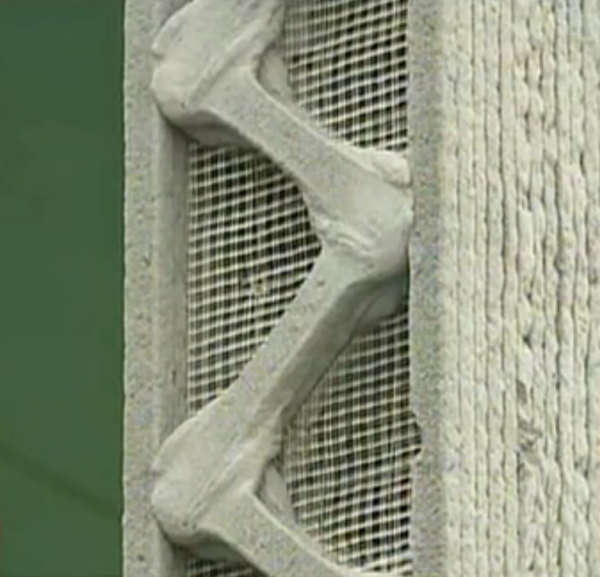

There is an opinion about the applicability of fiber-reinforced concrete and perhaps such a dome in one or two floors will withstand the certification procedure. It is also proposed to connect the fittings on shtivta, screwing, etc. Of course, this is bypass measures. Perhaps the problem of online reinforcement will be solved by using two robots at once: one mounts the reinforcement, the other lays the mixture. The automation situation is simplified by the fact that the formwork is absent as a “class”.
With the installation of engineering systems in terms of ventilation, sewage and heating is easier to solve. 3D printers are robots with fairly accurate repeatability of operations and the fitting of pipe elements in a given sequence is quite feasible. Naturally, industrial designers will have to break their heads over new designs of elements of engineering systems.
In general, most of these technical problems are characteristic of the transition period in which 3D printers enter. For some time old and new technologies will coexist, the time required, first of all, for psychological adaptation. When some builders criticize the 3D process, they criticize evolution - “Well, they say, the printer is big, expensive, it makes noise and consumes electricity, and your house falls apart. And in general, the bundle - the panel plus "TajikStroy" - does not happen cheaper ”.
So, building a 3D printer is not an evolution. Many in my head do not fit exactly this moment, because it is a revolution, and it must be realized.
Indeed, today it is difficult to imagine how the structure of a construction firm, or its subdivision specializing in cottage villages, will change. Apparently, there will be no additions and “dopniki” among foremen, there will be no replaceable Moldovan, Belarusian and other brigades. The company will face a small team of specialists and a couple of robots; the engineer-operator of the 3D-robot (3 people in three shifts), the logistics manager (the current supplier) and then –bangers –– bring the working mixture, install IT systems. A few more specialists during the process assemble reinforcement, mortgages and windows with doors. The staff of the construction unit is 12 people, with a salary fund of one million rubles a month. For this month, such a team village is fully commissioned. A fantastically short construction time, among other things, is the absence of financial gaps in the construction cycle, and the removal of the problem of seasonal natural cycles.
A 3D printer in construction is a robotization of production, a kind of conveyor. Naturally, all related industries in this chain meet the standards of the era of robots. Where the working mixture will be produced, how transport logistics will be solved (if the solution is prepared next to the object being erected, then delivery is not needed), the format of the component storage (a common one is created for the whole village or a connecting supplier brings the batch to a particular house), these and many other questions A solution will undoubtedly be offered. Specialists leading the development of volumetric printing technologies are very active, 3D methods are being introduced into the life of society at an unprecedented speed since the time of the first scientific and technological revolution. If during the presentation of Baruch Koshnevitsa, held in 2012, 2017-2020 was cautiously called the threshold for the start of operation of construction robots, in reality, in February 2014, a series of real houses in China were pointedly printed.
In addition to the possibility of building a truly inexpensive mass housing, let's say, of a standard class, there are original concepts that offer the opportunity to alleviate the shortage of housing in megacities. In Germany, Peter Ebner and his students printed a shell house.
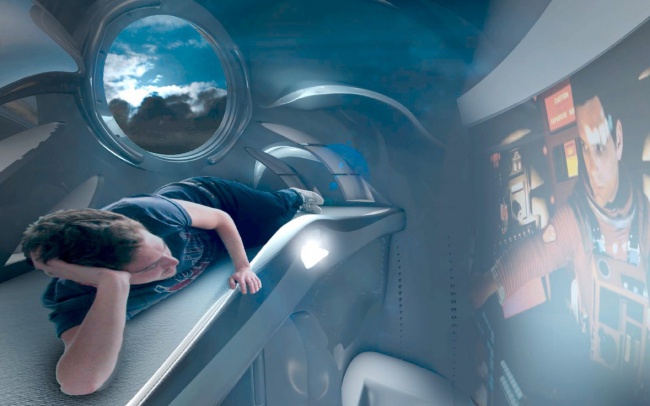
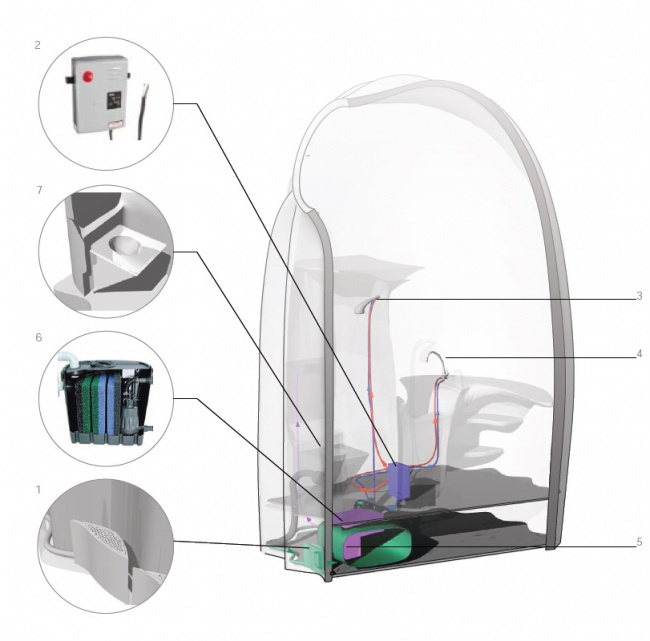

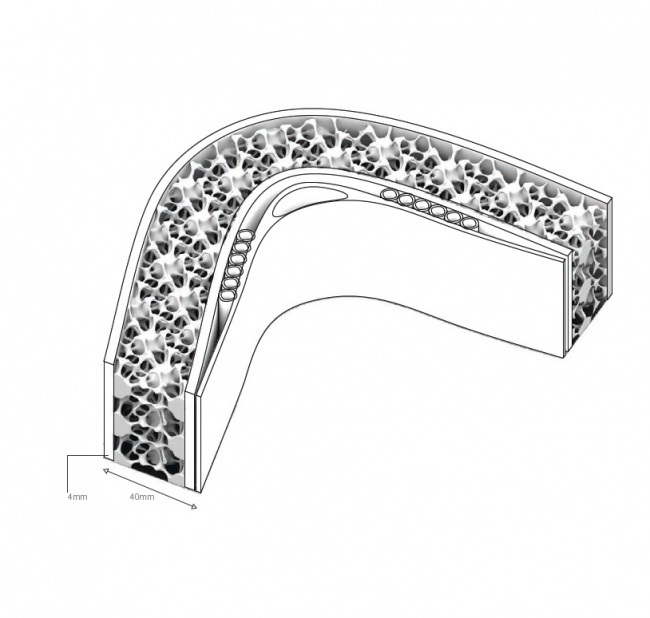
The use of 3D technologies in this generally known conceptual direction makes it possible to build and operate warm sink houses in northern Moscow on a massively and relatively inexpensive basis. Very many residents of the nearest Moscow region would have acquired such shells on the territory inside the Moscow Ring Road, to live in them from Monday evening to Friday morning.
It can be said that the conditions and definite frameworks have already been formed when an architect, a civil engineer and a construction engineer are able to produce a realistic, socially oriented project in a profitable business format. Naturally, with the help of material experts, logisticians, specialized engineers and designers. Only a comprehensive solution of the issues: socially demanded architectural forms and format of the settlement, conveniently mounted engineering components and special construction material, plus automated transport and warehouse logistics, will allow us to speak of a revolution in construction. And as manufacturers of 3D printers do not disappoint.
As you know, the main difference between a 3D printer and any other industrial robot is in the way of creating products. In particular, a 3D construction printer has a nozzle or an extruder and squeezes a fast-hardening working mixture out of it. The surface on which the volumetric product is created is called the working area and has the dimensions given by the nozzle stroke. And the formwork is not required. That is, the construction machine of volumetric printing is declared as a self-sufficient mechanism capable, when connecting electricity, to create a finished building literally from scratch.
There are three ways to create a three-dimensional structure:
1. Layer-by-layer extrusion of a viscous working mixture.
In this case, a creamy mixture of concrete with additives is squeezed out of the working “nozzle”, like a toothpaste from a tube.

')
He was the first to substantiate the concept of using a robot in construction, in the form of a crane-manipulator, placing a viscous concrete mix according to a given program, industrial designer Sergey Dudin together with specialists from the Moscow Institute of Chemical Engineering named after DI Mendeleev in 1995. The first public presentation of a similar technology in construction, organized by Professor Baruch Koshnewitz of the University of Southern California (University of Southern California) in August 2012. His group put forward the concept of a giant, assembled at the construction site of a printer like a bridge crane.
A group of scientists led by Dr. Sungwu Lima of Loughborough University, a British university, have printed the world's first hollow panel with double rounded contours.

The 3D printers of the Chinese company Shanghai WinSun Decoration Design Engineering Co, which first printed a series of real houses in early 2014, are built on the same principle.
2. Sintering method / selective sintering.
With this technology, in the working area of the 3D machine, the working mixture is melted, and melting is achieved, as applied to construction, by concentrated laser or a sunbeam, and the working mixture is ordinary sand. It is known, at the time of this writing, about the only existing sample of such a device, the inventor Marcus Kaiser, a student of the Royal College of Art (Royal College of Art).

3. Method of spraying / component glueing.
Known, in particular, a working sample of the Catalan Institute of Advanced Architecture (IAAC) group (Peter Novikov group) called Stone Spray Robot, as well as the D-Shape system developed by Enrico Dini (Monolite UK, (private company)) for the construction of buildings. At the same time, a stream of sand comes out of the working nozzle, which is immediately mixed with an adhesive / catalyst, forming a volume at a programmatically defined point.


Sintering and spraying methods, elegantly conceived because they use solar energy, are environmentally harmless (at least as long as there is a lot of sand on the planet), you can watch the movement of sand streams for hours and products come out in very unusual forms. Well, already now it is quite possible to build in such a way small architectural forms, a flower girl, for example, or a doghouse. In the meantime, it is difficult to even imagine what the resulting operational effect will be when creating a real, albeit small, house from molten sand and turned into a vitreous mass.
Of these methods of forming a volume, the attention of builders is attracted primarily by the method of layer-by-layer extrusion largely because sufficiently large bearing surfaces and even real houses have already been created.
And if European architects demonstrate, first of all, an aesthetic and ecological orientation, then the Chinese in their developments are extremely pragmatic.

Many 3D romantics frankly disappointed a series of simple and rude-looking houses of a Chinese company. At the same time, it is overlooked that these rectangular plain-wall structures are part of a clearly defined technological chain.
It is planned to massively build factories for the processing of construction waste and garbage, the resulting material will be used in the preparation of the working mixture for a 3D printer. Given China's great achievements in the field of bioenergy, namely the prevalence of wind, solar and bioelectric power plants, it can be assumed that giant construction waste shredders will be installed at landfills of construction debris, powered by electricity from the nearest bioelectric power station.
Constructed from a patented material (which is a mixture of construction waste, concrete and additives), the houses are segmented in the class of inexpensive prefabricated housing. This explains their inconspicuous appearance.
If we talk about the technology of 3D construction. then I would not put the 3D device in the first place. A construction printer is a link in a new technology, and perhaps not the most technically difficult.
After all, the construction of the construction robot is sufficiently developed. and for now houses are only Chinese series. Already there are in many instances two types of structures - in the form of a gantry crane and in the form of a boom-arm.
Much more questions are caused by the composition of the working mixture and conceptual architectural forms. In general, when drafting a working questionnaire on the topic, more than 30 items were formed on the move, the answer to some of them, according to the hilarious remark of engineer Sergei Zotov, requires writing a decent monograph. Zotov's group has already developed the composition of the working mixture and a 3D printer in the version of a “bridge crane”.
Also, an interesting concept, based on the idea of supplying the working mixture under high pressure to a 3D printer that has a rather elegant bridge structure, was proposed by industrial designer Sebastian Bernard.


The supply of thick concrete under high pressure translates the technology of bulk printing into a fairly realistic frame. Further, materials are being developed specifically for the application of this technology. In Russia, studies are known in Penza, at the Department of TBKiV of the Penza GUAS new types of concrete are being developed. New high-strength reactionary powder concretes (RPB) are quite suitable for construction robots.
For building a technological process, in addition to the working mixture, the important point is the architecture of the building itself and the group of buildings as a single building object. The most promising direction for Russia, apparently, is the construction of a village of two-storey town houses of arched forms. Approximately such as the domed house of architect Grebnev.

The format of an arched house with two floors will allow the use of relatively small and inexpensive 3D printers, solve the problem of overlapping and allow you to build, really, quickly, massively and inexpensively. And beautiful. On the scale of the settlement, bridge printers can also be used, since the rail track (not necessarily from metal rails) will move as construction progresses.
Many questions are directly related to construction technology. Firstly, how the seams going through every three to five centimeters will affect the strength of the structure. Secondly, the existing (from known) process of rebar placement is rather controversial. The Chinese reinforced fiberglass mesh. At least, it is visible on the video of the process.


There is an opinion about the applicability of fiber-reinforced concrete and perhaps such a dome in one or two floors will withstand the certification procedure. It is also proposed to connect the fittings on shtivta, screwing, etc. Of course, this is bypass measures. Perhaps the problem of online reinforcement will be solved by using two robots at once: one mounts the reinforcement, the other lays the mixture. The automation situation is simplified by the fact that the formwork is absent as a “class”.
With the installation of engineering systems in terms of ventilation, sewage and heating is easier to solve. 3D printers are robots with fairly accurate repeatability of operations and the fitting of pipe elements in a given sequence is quite feasible. Naturally, industrial designers will have to break their heads over new designs of elements of engineering systems.
In general, most of these technical problems are characteristic of the transition period in which 3D printers enter. For some time old and new technologies will coexist, the time required, first of all, for psychological adaptation. When some builders criticize the 3D process, they criticize evolution - “Well, they say, the printer is big, expensive, it makes noise and consumes electricity, and your house falls apart. And in general, the bundle - the panel plus "TajikStroy" - does not happen cheaper ”.
So, building a 3D printer is not an evolution. Many in my head do not fit exactly this moment, because it is a revolution, and it must be realized.
Indeed, today it is difficult to imagine how the structure of a construction firm, or its subdivision specializing in cottage villages, will change. Apparently, there will be no additions and “dopniki” among foremen, there will be no replaceable Moldovan, Belarusian and other brigades. The company will face a small team of specialists and a couple of robots; the engineer-operator of the 3D-robot (3 people in three shifts), the logistics manager (the current supplier) and then –bangers –– bring the working mixture, install IT systems. A few more specialists during the process assemble reinforcement, mortgages and windows with doors. The staff of the construction unit is 12 people, with a salary fund of one million rubles a month. For this month, such a team village is fully commissioned. A fantastically short construction time, among other things, is the absence of financial gaps in the construction cycle, and the removal of the problem of seasonal natural cycles.
A 3D printer in construction is a robotization of production, a kind of conveyor. Naturally, all related industries in this chain meet the standards of the era of robots. Where the working mixture will be produced, how transport logistics will be solved (if the solution is prepared next to the object being erected, then delivery is not needed), the format of the component storage (a common one is created for the whole village or a connecting supplier brings the batch to a particular house), these and many other questions A solution will undoubtedly be offered. Specialists leading the development of volumetric printing technologies are very active, 3D methods are being introduced into the life of society at an unprecedented speed since the time of the first scientific and technological revolution. If during the presentation of Baruch Koshnevitsa, held in 2012, 2017-2020 was cautiously called the threshold for the start of operation of construction robots, in reality, in February 2014, a series of real houses in China were pointedly printed.
In addition to the possibility of building a truly inexpensive mass housing, let's say, of a standard class, there are original concepts that offer the opportunity to alleviate the shortage of housing in megacities. In Germany, Peter Ebner and his students printed a shell house.




The use of 3D technologies in this generally known conceptual direction makes it possible to build and operate warm sink houses in northern Moscow on a massively and relatively inexpensive basis. Very many residents of the nearest Moscow region would have acquired such shells on the territory inside the Moscow Ring Road, to live in them from Monday evening to Friday morning.
It can be said that the conditions and definite frameworks have already been formed when an architect, a civil engineer and a construction engineer are able to produce a realistic, socially oriented project in a profitable business format. Naturally, with the help of material experts, logisticians, specialized engineers and designers. Only a comprehensive solution of the issues: socially demanded architectural forms and format of the settlement, conveniently mounted engineering components and special construction material, plus automated transport and warehouse logistics, will allow us to speak of a revolution in construction. And as manufacturers of 3D printers do not disappoint.
Source: https://habr.com/ru/post/224299/
All Articles